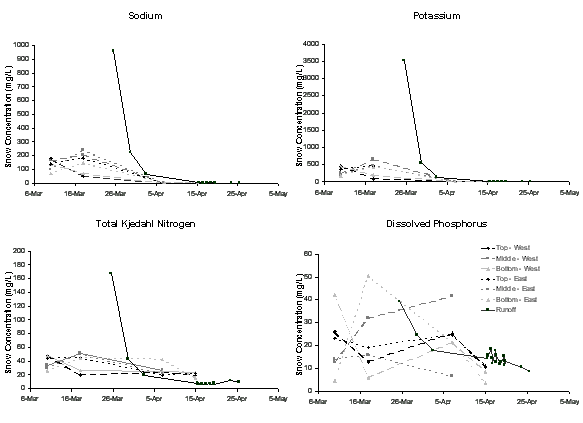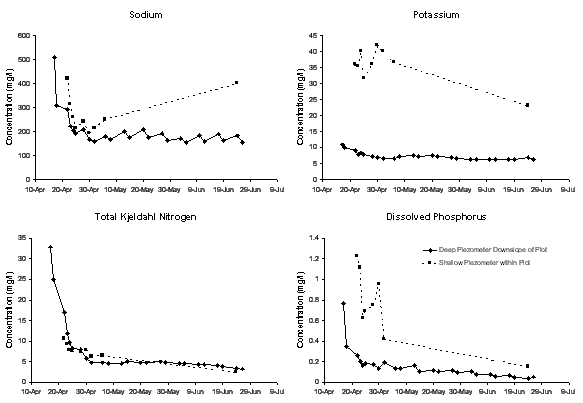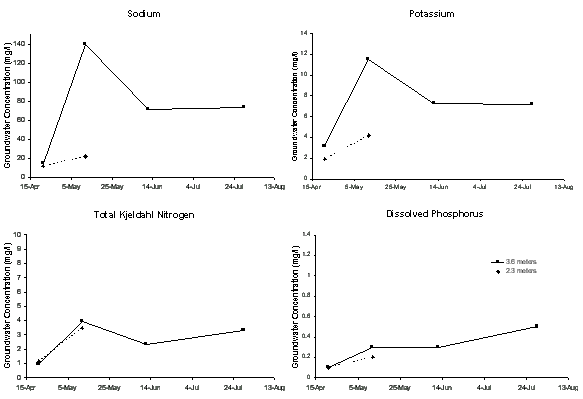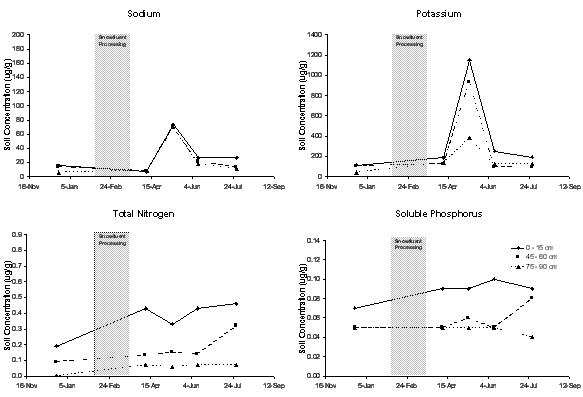| Changes in snow and meltwater composition with aging of Snowfluent treated food processing wastewater snowpack | Infiltration and transport of meltwater from Snowfluent - treated food processing wastewater | Production of odour during Snowfluent processing | Effects of Snowfluent treatment on biological pathogens | Effects of Snowfluent - treated food processing wastewater on soils | Crop response to Snowfluent - treated food processing wastewater
Changes in Snow and Meltwater Composition with Aging of Snowfluent Treated Food Processing Wastewater Snowpack
Separation of soluble salts from the bulk of the Snowfluent -processed wastewater occurred as the snow piles aged and melted. Highly soluble salts like sodium and potassium were concentrated in the initial meltwater draining from the snow piles, with over 80% of the soluble salt load in the first 20% of the meltwater. Less-soluble material, including precipitates of phosphorus and nitrogen compounds, remained in place after the snow had melted, resulting in a residue rich in plant nutrients.
The concentrations of soluble constituents in the snow changed significantly as the snowpack aged. Concentrations of sodium, potassium, Total Kjedahl Nitrogen (TKN) and dissolved phosphorus (DP) in samples of snow collected throughout the snow pile in the lined plot as it aged during the 1997 trial are shown in Figure 2. Concentrations of soluble constituents, like sodium and potassium, decreased at the top of the pile. However concentrations of these soluble constituents initially increased at the middle and bottom of the pile before decreasing as the snow pile aged.
Less-soluble constituents remained with the snow as it aged. TKN, which includes both soluble and less-soluble nitrogen-containing compounds, showed this with the less-soluble constituents remaining in the snow pile. With time, the amount of snow in the pile decreased, but the concentrations of TKN only decreased slightly. If no TKN were lost, the concentration would have increased. Since the TKN concentration remained relatively constant, this indicates that some soluble nitrogen compounds were lost. Increases in concentration were observed for dissolved phosphorous.
The removal of the soluble constituents from the snow is a leaching process described by Johannessen and Hendriksen (1978) for natural snowpacks. The snowpack melts from the top down. The resulting meltwater trickles down through the pack collecting soluble constituents, which are more soluble in the water than in the snow. With aging, more leaching occurs and the soluble constituents are carried deeper into the snow pile. Analyses of snow samples from the snowpack, indicated that almost all of the soluble constituents were removed less than two weeks after runoff began.
The concentrations of highly soluble constituents such as sodium and potassium, in the initial meltwater runoff were very high, over 5 times higher than concentrations in the raw effluent. However after the initial melt, concentrations quickly decreased (Figure 2). The concentrations of less-soluble constituents remained relatively constant in the snow. The differences between the initial meltwater and the later runoff were much less pronounced for the less-soluble constituents than for the soluble constituents.
The concentration of TKN and dissolved phosphorus in snow and meltwater are shown in Figure 2. These constituents were not removed from the snow as were sodium and potassium. The concentrations in snow did not change significantly through the entire snowmelt and are higher than concentrations in the meltwater, indicating that some of these material remained behind. Figure 2 does not fully illustrate this phenomenon because the crust of low solubility material formed on the surface of the snow pile is not graphed. After snowmelt and runoff, a residue rich in plant nutrients remained: 5 % nitrogen, 2 % phosphorus, 2 % potassium and 70 % organic material (based on loss on ignition). The residue contained a very small amount of sodium, less than 10 mg/l.

Figure 2. Concentrations of selected parameters in snow and meltwater runoff from the 1997 lined plot trial.
Infiltration and Transport of Meltwater from Snowfluent -Treated Food Processing Wastewater
Increased concentrations of soluble constituents of the processed wastewater were found in groundwater at and downslope of the unlined plot as the snow melted during the 1997 trial. Concentrations in groundwater downslope of the plot returned to pretrial levels by the end of the snowmelt but concentrations of sodium and potassium remained higher in groundwater directly beneath the snow pile.
Piezometer nests were installed upslope of, within and downslope of the unlined test plot. Piezometers of depths 0.8, 1.6 and 2.4 meters were included in each nest. None of the piezometers produced groundwater at the time of installation in January 1997. Piezometers upslope of the test plot did not produce any water throughout the trial. Concentrations of representative constituents of the effluent, in groundwater samples collected from the deep downslope piezometers (a composite sample of two deep piezometers) and the shallow piezometer on the downslope side of the test plot are shown in Figure 3.

Figure 3. Concentrations of selected parameters in shallow groundwater collected downslope of the unlined plot during the 1997 trial.
All samples were collected from piezometers on the downslope side of the snow pile. Wastewater constituents in shallow groundwater samples collected from piezometers within the plot are the result of meltwater that infiltrated and remained perched on top of frozen soil. No samples were collected from the deeper piezometers of the nest. Wastewater constituents in shallow groundwater collected from piezometers downslope of the test plot are the result of infiltration of meltwater at the test plot, followed by subsurface flow downslope, on top of the underlying frost lens.
The results from the deep piezometers downslope of the test plot showed the influence of the Snowfluent meltwater. All parameters had elevated initial concentrations followed by decreases over time. The profiles of the concentrations of parameters are very similar, indicating movement in the shallow groundwater. However much higher concentrations of potassium were found in the shallow groundwater under the test plot, showing significant retention of potassium at the area of infiltration. This was the result of potassium exchanging for sodium at cation exchange sites in the soil. The increase in the sodium concentration in groundwater at the piezometer inside the plot, in late June, was the result of potassium leaching from the Snowfluent residue and exchanging for sodium in the solenetzic soil.
Production of Odour During Snowfluent Processing
No odour problems were encountered during the 1997 pilot scale trial when fresh wastewater was processed. Objectionable odour was only observed directly in the area where the snow plume was falling. The snow piles and meltwater had odour levels that were much less than the wastewater fresh from the malting plant.
Considerable odour problems were encountered in the 1998 productions scale trial when wastewater had been stored under anaerobic conditions. A strong, unpleasant odour plume, 40 metres wide, was observed a kilometre downwind of the snowmaking towers. The source of this odour was believed to be amines and sulphides produced by anaerobic digestion of proteins and sulphate in the storage lagoon. The lagoon wastewater in 1998 had a stronger odour and three times the concentration of ammonia compared to the 1997 wastewater fresh from the malting plant. The 1997 tests showed that the Snowfluent process is efficient at stripping odours from wastewater. However, under weather and watewater conditions encountered in 1998, this became a liability when the odour plume travelled off-site. While the odour problems in 1998 point to the need for odour treatment in lagoons, the comparison of odour in the 1997 tests to the 1998 test suggests that processing the wastewater by minimizing storage time in lagoons during the winter also is an option to reduce this odour problem.
Effects of Snowfluent Treatment on Biological Pathogens
There are two concerns regarding bacteria in the treatment of wastewater using Snowfluent . First, what is the effect of Snowfluent in disinfecting or reducing the number of bacteria in the wastewater? Second, what are the increase in risks, if any, to workers and nearby populations?
Snowfluent is an effective treatment of biological pathogens. In the 1997 test, the average concentration of fecal coliforms was 20 colony forming units (cfu)/100 ml in the early meltwater (prior to April 15) and 2 cfu/100 ml in later meltwater. This represents reductions of 4 and 5 log units respectively from the initial wastewaters. Significant levels of bacteria were killed at the snowmaking stage. However, effects were variable and reductions did not exceed 1 log unit. In 1997 a reduction of 45 % was observed at snowmaking while in 1998 a reduction of 85% and an increase of 8 % were observed at snowmaking in two separate tests. These tests found that most of the reduction occurred during the snowpack aging.
To determine if there was an increased human health risks associated with Snowfluent , air samples were collected during the snowmaking process and the concentrations of total bacteria (heterotrophic plate count), faecal coliform and faecal Enterococcus bacteria determined. Samples were collected upwind of the snow gun (control sample) and at three distances downwind of the snow gun, 6 meters downwind of the snow gun, 16 meters downwind of the snow gun, directly in the snow deposition zone, 25 meters downwind of the snow gun, and 100 meters downwind, well beyond the snow deposition zone. Concentrations of bacteria found in these samples are shown in Table 2. Concentrations 100 meters downwind of the snow gun do not differ significantly from those upwind of the snow gun. The highest concentrations were observed in the deposition zone. These concentration were above the threshold for reduced pulmonary function reported by Donham et al. (1989) in their study of air-bourne bacteria in Swedish swine confinement buildings. These findings indicate that there is a significant risk to operators working in or near the snow plume. It is recommended that operators processing food-processing wastewater wear breathing protection when working in and around the snow plume.
Concentrations of bacteria well downwind of the plume were not significantly different than those upwind of the snow gun, indicating that there was no significant risk at these distances from the snowmaking towers.
Table 2. Bioaerosols measured in and around snow plume during snowmaking.
Distance Downwind of snow gun (m) | n | Heterotrophic plate count (cfu/m3) | Fecal Enterococcus (cfu/m3) |
Upwind | 2 | 3,580 | 237 |
6 | 2 | 1,300 | 15 |
16 | 2 | 22,000,000 | 126,000 |
25 | 1 | 1,500,000 | 24,000 |
100 | 2 | 40 | 13 |
Effects of Snowfluent -Treated Food Processing Wastewater on Groundwater
In the 1998 production scale trial, significant increases in sodium concentrations occurred in groundwater at and immediately downslope of the Snowfluent -processed wastewater snow piles. Very small increases in potassium concentrations were also observed. No changes in the concentrations of TKN or dissolved phosphorus that could be attributed to the effects of processed wastewater were observed. High pre-existing concentrations of nitrogen and phosphorus in surface soils throughout the study area may have masked some minor effects of Snowfluent . Elevated concentrations of dissolved organic carbon, with accompanying increases in biochemical oxygen demand, were also found in a pattern analogous to that of sodium.
Concentrations of malting effluent constituents in groundwater and soil showed no transport through groundwater flow in the water table. No significant surface flow of meltwater was observed, indicating that all transport was through subsurface flow on top of frozen ground. Groundwater south of the drainage path (p08 and p14), showed no Snowfluent related effects. Concentrations of malting effluent constituents in groundwater wells along the drainage path followed a pattern similar to that observed in the 1997 pilot scale trial. The highest concentrations found in groundwater were near or beneath the snow piles. Downslope of the snow piles, concentrations in groundwater decreased with distance. No contaminants were found in groundwater upslope of the snow piles.
Concentrations of sodium and potassium in groundwater immediately downslope of the snow pile rose sharply in early May, coinciding with the snowmelt in late April and early May (Figure 4). Concentrations decreased, but remained significantly higher than before the snowmelt. Potassium concentrations increased from 3 to 6 mg/l while sodium concentrations increased from 15 to 70 mg/l. No changes were observed in groundwater further downslope of the snow piles.

Figure 4. Groundwater concentrations of malting effluent constituents at piezometer nest p07 at 2.3 and 3.6 meters.
Concentrations of TKN and dissolved phosphorus in groundwater immediately downslope of the snow piles exhibit a more complicated pattern of change with time (Figure 4). This is likely due to the levels of nitrogen and phosphorus that were present in the study area’s soils before Snowfluent snow was applied. Increases in concentration, which coincided with the snowmelt, occurred. However concentrations of dissolved phosphorus continued to increase through the remainder of the trial. And while there was a slight decrease in TKN following the snowmelt, it also increased later in the trial. Similar increases in groundwater concentrations were observed at sites not affected by Snowfluent snow piles.
Effects of Snowfluent -Treated Food Processing Wastewater on Soils
Increased soil concentrations of sodium and potassium were observed in soil under and immediately downslope of the Snowfluent -processed wastewater snow piles. Sodium was evenly distributed through the soil profile to a depth of 0.9 m but concentrations of potassium decreased with depth, indicating binding in the upper soil layers. Concentrations of each decreased after the snowmelt, returning to pretrial levels.

Figure 5. Soil concentrations of malting effluent constituents at piezometer nest site p07 from depths of: 0-15 cm, 45-60 cm and 75-90 cm.
Significant concentrations of potassium, TKN and soluble phosphorus were present in surface soils (0 to 15 cm) throughout the site prior to the application of Snowfluent . At p07, immediately downslope of the snow piles in the drainage path, increases in both sodium and potassium occurred in early May, coincidental with increases in groundwater concentrations (Figure 5). Soil concentrations of sodium in May did not change with depth. However soil concentrations of potassium decreased with increasing depth indicating less mobility in soil, probably due to potassium replacing sodium on ion exchange sites. The subsequent decrease in soil concentrations of both sodium and potassium is likely due to leaching by the second stage of meltwater, deficient in ions, as it percolates through the ground.
A similar pattern in soil concentrations of sodium and potassium was observed at piezometer nest p10. However, concentrations did not decrease to the same extent after the peak and peak concentrations of potassium occurred earlier, in April. Similar concentrations of sodium were found at all depths but potassium was concentrated in the surface layer. The reason for the increase of sodium and potassium in the surface layer at the end of July is not known. No increase occurred in the July samples taken from the well site, dw3, 3.3 metres south of the p10 site. No Snowfluent impact was observed in soil samples collected at piezometer nest p12, further downslope and along the drainage path.
Crop Response to Snowfluent -Treated Food Processing Wastewater
Native pasture and alfalfa hay both benefited from Snowfluent processed wastewater. Better crop growth and fewer weeds were observed in the area of the snow piles after melting. This is probably the result of increased soil moisture as ample plant nutrients were present in surface soils throughout the study area. Areas of natural snow and water accumulation outside the snowmaking area also displayed the same effects.
The vegetation on the study site was split. The south end of the site was seeded to alfalfa with a cover crop in 1997. The north half of the site was native grass pasture. There was some concern that a snow cover that persisted into the growing season would negatively affect the alfalfa and the native grass pasture. Both forages showed a favourable response in a geometric shape, which followed the outline of the Snowfluent snow deposition. This favourable response was characterized by a taller, greener, lusher growth in the pasture and the alfalfa field. The alfalfa field had fewer weed plants where Snowfluent snow was applied. Alfalfa showed excellent survival and quick growth after the large snow piles had melted. Within two weeks of a snow pile disappearing, the alfalfa under the snow pile had nearly caught up in growth with adjoining areas. The Snowfluent snow-covered areas of the alfalfa hayfield produced approximately three times the dry weight yield of dryland areas. This was primarily due to the additional moisture since areas of natural snow and water accumulation outside the snowmaking area also displayed these characteristics. The vegetation beneath the two largest piles of Snowfluent snow was not exposed until early May, and apart from being delayed showed no other visible negative effects. Small areas of temporary water ponding drowned out the alfalfa.
Cattle and horses were observed to preferentially graze pasture originally covered by Snowfluent snow. More vigorous pasture was likely the primary attractant.
Alfalfa is a viable and valuable forage alternative for Snowfluent land application. Except for low areas or areas where temporary ponding occurs, alfalfa will survive and produce well even under conditions of delayed exposure. |